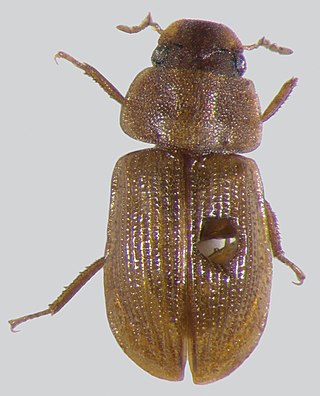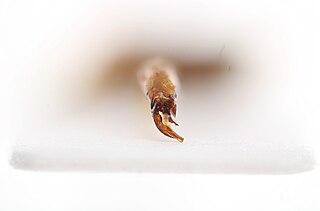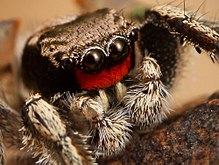
The cephalothorax, also called prosoma in some groups, is a tagma of various arthropods, comprising the head and the thorax fused together, as distinct from the abdomen behind. The word cephalothorax is derived from the Greek words for head and thorax. This fusion of the head and thorax is seen in chelicerates and crustaceans; in other groups, such as the Hexapoda, the head remains free of the thorax. In horseshoe crabs and many crustaceans, a hard shell called the carapace covers the cephalothorax.

This glossary of entomology describes terms used in the formal study of insect species by entomologists.

The (pan)arthropod head problem is a long-standing zoological dispute concerning the segmental composition of the heads of the various arthropod groups, and how they are evolutionarily related to each other. While the dispute has historically centered on the exact make-up of the insect head, it has been widened to include other living arthropods, such as chelicerates, myriapods, and crustaceans, as well as fossil forms, such as the many arthropods known from exceptionally preserved Cambrian faunas. While the topic has classically been based on insect embryology, in recent years a great deal of developmental molecular data has become available. Dozens of more or less distinct solutions to the problem, dating back to at least 1897, have been published, including several in the 2000s.

Insect morphology is the study and description of the physical form of insects. The terminology used to describe insects is similar to that used for other arthropods due to their shared evolutionary history. Three physical features separate insects from other arthropods: they have a body divided into three regions, three pairs of legs, and mouthparts located outside of the head capsule. This position of the mouthparts divides them from their closest relatives, the non-insect hexapods, which include Protura, Diplura, and Collembola.

Leptostylopsis annulipes is a species of longhorn beetles of the subfamily Lamiinae.
This glossary describes the terms used in formal descriptions of spiders; where applicable these terms are used in describing other arachnids.

Cebrionini is a tribe of click beetles from the family Elateridae; formerly ranked as a subfamily or family, they are now considered a tribe within the subfamily Elaterinae.

Kollasmosoma sentum is a parasitoid wasp in the family Braconidae, which lays its eggs inside adult ants. It was featured as one of "the top 10 new species of 2012" in a list compiled by Conservationists at the Arizona State University International Institute for Species Exploration.

Zigrasimecia is an extinct genus of ants which existed in the Cretaceous period approximately 98 million years ago. The first specimens were collected from Burmese amber in Kachin State, 100 kilometres (62 mi) west of Myitkyina town in Myanmar. In 2013, palaeoentomologists Phillip Barden and David Grimaldi published a paper describing and naming Zigrasimecia tonsora. They described a dealate female with unusual features, notably the highly specialized mandibles. Other features include large ocelli, short scapes, 12 antennomeres, small eyes, and a clypeal margin that has a row of peg-like denticles. The genus Zigrasimecia was originally incertae sedis within Formicidae until a second species, Zigrasimecia ferox, was described in 2014, leading to its placement in the subfamily Sphecomyrminae. Later, it was considered to belong to the distinct subfamily Zigrasimeciinae.

Sphinctomyrmex stali is a Neotropical species of ants in the subfamily Dorylinae. Mayr described the genus Sphinctomyrmex with S. stali as its type species, based on a single dealate gyne. However, except for the holotype, there are no records of normal (alate) gynes for S. stali. All reproductive females collected after the original description are ergatoids.
Pristomyrmex tsujii is a species of ant in the genus Pristomyrmex. Known from Fiji, where they are widely distributed but rarely encountered. The species has a discrete ergatoid queen caste that is intermediate between a worker and an alate queen.

Nothophantes, the horrid ground-weaver, is a critically endangered monotypic genus of European dwarf spiders containing the single species, Nothophantes horridus. It was first described by P. Merrett & R. A. Stevens in 1995, and has only been found in an area of Plymouth smaller than 1 square kilometre (0.39 sq mi). The genus name comes from the Ancient Greek νόθος, meaning "spurious", and hyphantes, meaning "weaver". The species name comes from the Latin horridus, meaning "bristly".
Cecinothofagus is a genus of wasps. Its name is derived from cecidium and Nothofagus, the name of the host plant genus. This genus differs from Paraulax by a median vertical carina that extends from the ventral margin of the clypeus, almost reaching the ventral margin of the antennal sockets; its facial strigae radiating from the lateral clypeus; the ventral part of its clypeus is straight; a lateral, sharp occipital carina is present; its last antennal flagellomere is 1.5 to 1.7 times longer than wide; longitudinal costulae running from the lateral margin of its pronotal plate to the lateral surface of its pronotum are very short or absent altogether; notauli are sinuate; no scutellar foveae are present; simple claws, sometimes carrying a short basal lobe.

Gerontoformica is an extinct genus of stem-group ants. The genus contains thirteen described species known from Late Cretaceous fossils found in Asia and Europe. The species were described between 2004 and 2016, with a number of the species formerly being placed into the junior synonym genus Sphecomyrmodes.

Camelomecia is an extinct genus of stem-group ants not placed into any Formicidae subfamily and probably not into Formicidae itself. Fossils of the single known species, Camelomecia janovitzi, are known from the Middle Cretaceous of Asia. The genus is one of several ants described from Middle Cretaceous ambers of Myanmar.

Hylaeus agilis is a bee species in the family Colletidae. It is endemic to New Zealand. This species is found throughout the country and visits the flowers of a wide variety of plant species, both native and introduced.

Acidocerus aphodioides is a species of water scavenger beetle in the family Hydrophilidae. It is the only species in the genus Acidocerus. It is known only from Mozambique.

Phaeochrous is a genus of beetles belonging to the family Hybosoridae. The species are widely distributed over tropical Africa, Madagascar, Aldabra, Yemen, South Asia, South-East Asia, New Guinea and Oceanian islands, as well as North and West Australia.
Geophilus proximus is a species of soil centipede in the family Geophilidae found in the northern part of the Palearctic and widespread across the entire Baltic basin, though it reaches as far as the Arctic Circle and has been introduced through human agency to northern, central, and eastern parts of Kazakhstan. It was recorded once with certainty in Britain from Unst in the Shetland Islands; distribution in the rest of Europe is difficult to assess because of frequent misidentifications of the species. Populations from northern Europe are mostly parthenogenetic.
Pholcomma turbotti is a species of spider in the family Theridiidae. The species was first described by Brian John Marples in 1956. Formerly thought to be endemic to Manawatāwhi / Three Kings Islands to the northwest of New Zealand, the species has since been identified on Cuvier Island.

















